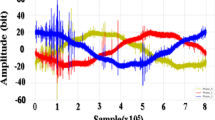Abstract
With the development and advancement of machine learning (ML), different aspects of our daily lives are now changed and revolutionized. Diverse ML-based smart and intelligent algorithms are deployed to detect faults in wires, especially in power cables. These approaches are beneficial for reliable, and better wire designs as some of them can estimate marks before they happen. Different sensing devices are made with the integration of intelligent ML-based methods to make the traditional fault detection methods very effective and productive. With the integration of machine learning and artificial intelligence-based architectures, fault detection is now very developed and efficient. Due to the deployment of these technologies in various sectors like power transmission networks, many people's lives can be saved. These intelligent procedures primarily work in real-time and can provide assistance and guidance within no time during any unwanted situation. Current research has considered that the Byol algorithm is used to detect wire damage for safety procedures. The experimental work was done, and the applications of the algorithm in the area of research show the effectiveness of the study. In this study, various parametric measures were used for the validation of the study.







Similar content being viewed by others
References
Babu NS, Mohankumar N (2019) Wire load variation-based hardware trojan detection using machine learning techniques. Soft computing and signal processing. Springer, Singapore, pp 613–623
Chesnokov A, Mikhailov V, Dolmatov I (2019) Evaluation of adverse factors acting on a pre-stressed wire rope structure by means of artificial neural network. In: 2019 1st International conference on control systems, mathematical modelling, automation and energy efficiency (SUMMA), pp. 500-504
Coutinho M et al (2021) Machine learning-based system for fault detection on anchor rods of cable-stayed power transmission towers. Electric Power Syst Res 194:107106
Cuartas M, Ruiz E, Ferreño D, Setién J, Arroyo V, Gutiérrez-Solana F (2021) Machine learning algorithms for the prediction of non-metallic inclusions in steel wires for tire reinforcement. J Intell Manuf 32(6):1739–1751
Gonzalez-Jimenez D, del Olmo J, Poza J, Garramiola F, Sarasola I (2021) Machine learning-based fault detection and diagnosis of faulty power connections of induction machines. Energies 14(16):4886
Hochreiter S, Schmidhuber J (1997) Long short-term memory. Neural Comput 9(8):1735–1780
Huang X, Liu Z, Zhang X, Kang J, Zhang M, Guo Y (2020) Surface damage detection for steel wire ropes using deep learning and computer vision techniques. Measurement 161:107843
Huang J, Haq IU, Dai C, Khan S, Nazir S, Imtiaz M (2021) Isolated handwritten pashto character recognition using a K-NN classification tool based on Zoning and HOG feature extraction techniques. Complexity 2021:5558373
Jehangir S, Khan S, Khan S, Nazir S, Hussain A (2021) Zernike moments based handwritten pashto character recognition using linear discriminant analysis. Mehran Univ Res J Eng Technol 40(1):152–159
Khan H et al (2014) A comparative and spatial study of various areas of Khyber Pakhtunkhwa- an education perspective. Life Sci J 11(10s):141–148
Le V, Yao X, Miller C, Tsao B-H (2020) Series DC arc fault detection based on ensemble machine learning. IEEE Trans Power Electron 35(8):7826–7839
Li Y et al (2021) A defect detection system for wire arc additive manufacturing using incremental learning. J Ind Inf Integr 2021:100291
Liu S, Sun Y, Jiang X, Kang Y (2020) A review of wire rope detection methods, sensors and signal processing techniques. J Nondestr Eval 39(4):1–18
Mahmoodian N, Schaufler A, Pashazadeh A, Boese A, Friebe M, Illanes A (2019) Proximal detection of guide wire perforation using feature extraction from bispectral audio signal analysis combined with machine learning. Comput Biol Med 107:10–17
Mishra DP, Ray P (2018) Fault detection, location and classification of a transmission line. Neural Comput Appl 30(5):1377–1424
Okaro IA, Jayasinghe S, Sutcliffe C, Black K, Paoletti P, Green PL (2019) Automatic fault detection for laser powder-bed fusion using semi-supervised machine learning. Addit Manuf 27:42–53
Srinivasan D, Cheu RL, Poh YP, Ng AKC (2000) Automated fault detection in power distribution networks using a hybrid fuzzy–genetic algorithm approach. Eng Appl Artif Intell 13(4):407–418
Tan L, Li P, Tao F, Miao A, Cao M (2020) Cable joint fault detection for the ring main unit based on an adaptive TNPE algorithm. Wiley Interdiscipl Rev Data Min Knowl Discov 10(1):e1336
Varghese A, Gubbi J, Sharma H, Balamuralidhar P (2017) Power infrastructure monitoring and damage detection using drone captured images. In: 2017 international joint conference on neural networks (IJCNN), pp. 1681-1687
Wong SY, Choe CWC, Goh HH, Low YW, Cheah DYS, Pang C (2021) Power transmission line fault detection and diagnosis based on artificial intelligence approach and its development in UAV: a review. Arab J Sci Eng 2021:1–27
Zhang L, Wang Z, Wang L, Zhang Z, Chen X, Meng L (2021) Machine learning based real-time visible fatigue crack growth detection. Digit Commun Netw 7:551–558
Zhou P, Zhou G, He Z, Tang C, Zhu Z, Li W (2019) A novel texture-based damage detection method for wire ropes. Measurement 148:106954
Funding
No fund is used regarding this research.
Author information
Authors and Affiliations
Corresponding author
Ethics declarations
Conflict of interest
The authors declare no conflict of interest.
Data availability
The data presented in this study are available on request from the corresponding author.
Additional information
Communicated by Shah Nazir.
Publisher's Note
Springer Nature remains neutral with regard to jurisdictional claims in published maps and institutional affiliations.
Rights and permissions
About this article
Cite this article
Guo, Z., Wang, C., Tian, Y. et al. Application of machine learning in wire damage detection for safety procedure. Soft Comput 26, 10623–10631 (2022). https://doi.org/10.1007/s00500-022-06747-z
Accepted:
Published:
Issue Date:
DOI: https://doi.org/10.1007/s00500-022-06747-z




